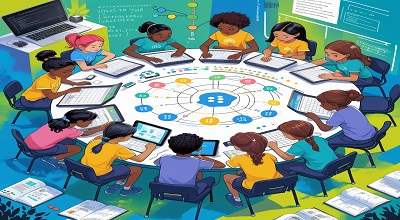Coding & Creativity Enhance Digital Fluency in Classrooms
Coding & Creativity Enhance Digital Fluency in Classrooms: In today’s rapidly evolving digital landscape, coding and creativity have become essential skills for students. The integration of technology in education has given rise to a new form of literacy—digital fluency. This goes beyond basic computer skills, empowering students to think critically, solve problems, and express themselves innovatively.
At TeacherEducator.com, we explore how educators can leverage coding and creative digital tools to enhance classroom engagement. This comprehensive guide delves into the latest trends, strategies, and benefits of fostering digital fluency in students.
The Importance of Digital Fluency in Modern Education
What is Digital Fluency?
Digital fluency refers to the ability to use technology effectively, creatively, and ethically. Unlike digital literacy (basic understanding), fluency involves:
- Problem-solving through computational thinking.
- Innovation by creating digital content.
- Collaboration using online platforms.
Why Does It Matter?
- Prepares students for future careers (AI, data science, cybersecurity).
- Encourages active learning through interactive tools.
- Bridges the digital divide by providing equitable tech access.
Coding as a Gateway to Creative Thinking
How Coding Stimulates Creativity?
Coding isn’t just about writing lines of text—it’s a form of digital storytelling. Students learn to:
- Design games (Scratch, Python).
- Build websites (HTML, CSS).
- Develop apps (JavaScript, Swift).
Benefits of Teaching Coding Early
- Improves logical reasoning.
- Boosts confidence through project-based learning.
- Encourages experimentation and resilience.
How Creativity Enhances Learning in STEM & Beyond?
The Role of Arts in STEM (STEAM)
Integrating arts into STEM (Science, Technology, Engineering, Math) fosters:
- Innovation (e.g., 3D modeling in engineering).
- Emotional intelligence (digital art, music coding).
Creative Coding Projects for Students
- Interactive storytelling with Twine.
- AI-generated art using Runway ML.
- Music composition with Sonic Pi.
Strategies to Integrate Coding and Creativity in the Classroom
1. Gamification of Learning
- Use Minecraft Education for collaborative coding.
- Introduce coding puzzles (Code.org, Blockly).
2. Project-Based Learning (PBL)
- Let students build a website or design a game.
- Encourage peer feedback and iteration.
3. Cross-Curricular Integration
- Math + Coding: Create geometric art with Python.
- History + Digital Storytelling: Build interactive timelines.
Top Digital Tools for Engaging Students
| Tool | Use Case | Grade Level |
|---|---|---|
| Scratch | Game design & animations | Elementary |
| Tinkercad | 3D modeling & prototyping | Middle School |
| Google CS First | Themed coding projects | All Ages |
| Canva for Education | Digital storytelling | High School |
| Repl.it | Collaborative coding environment | College |
Case Studies: Schools Successfully Implementing Digital Fluency
Example 1: Finland’s Coding Curriculum
- Mandatory coding from age 7.
- Focus on creativity, not just syntax.
Example 2: Singapore’s AI for Students Program
- Teaches machine learning in high schools.
- Encourages ethical tech use.
Challenges and Solutions in Teaching Digital Skills
Common Challenges
- Lack of teacher training.
- Limited access to devices.
- Student disengagement.
Solutions
- Professional development workshops.
- Offline coding activities (unplugged coding).
- Gamified rewards for participation.
Future Trends: The Evolving Role of Coding in Education
- AI-assisted coding tutors (GitHub Copilot in classrooms).
- VR/AR coding environments (Meta’s Code Lab).
- Global coding collaborations (students working on international projects).
Conclusion: Preparing Students for a Digital Future
Digital fluency is no longer optional—it’s a necessity. By integrating coding and creativity into classrooms, educators can:
✔ Enhance engagement.
✔ Develop future-ready skills.
✔ Foster innovation.
Start small, experiment, and watch students thrive in the digital age!
Final Thoughts
By embracing coding, creativity, and digital fluency, educators can transform classrooms into dynamic learning hubs. For more resources, visit TeacherEducator.com.
